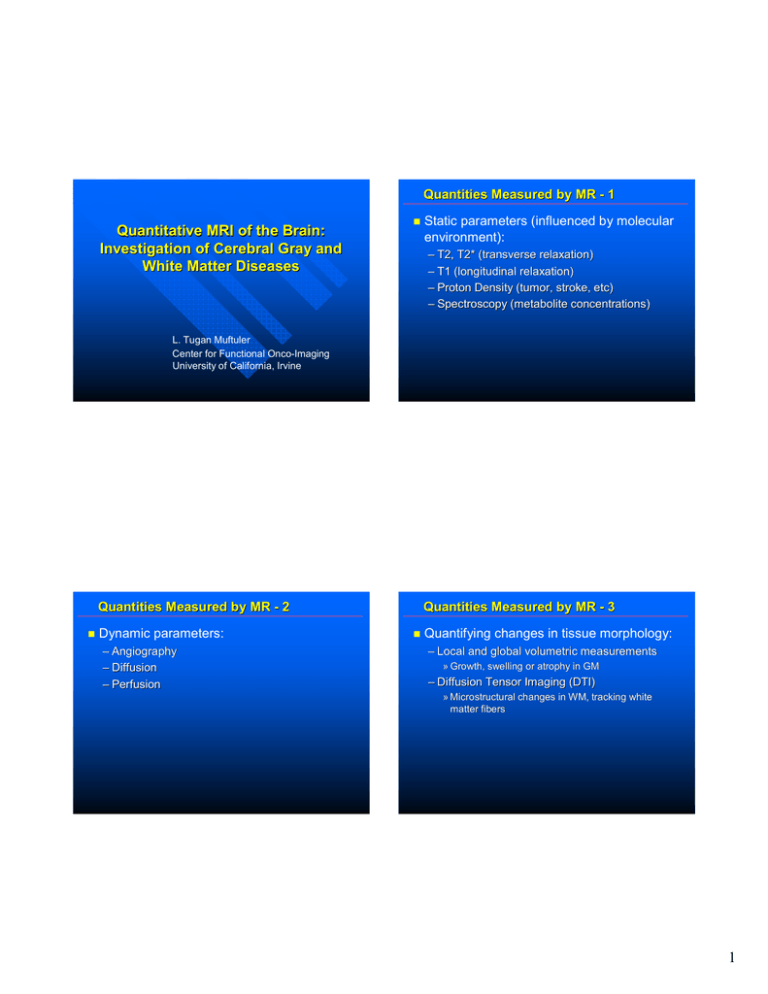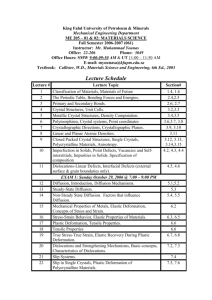Quantitative MRI of the Brain: Investigation of Cerebral Gray and
advertisement

Quantities Measured by MR - 1
Quantitative MRI of the Brain:
Investigation of Cerebral Gray and
White Matter Diseases
Static parameters (influenced by molecular
environment):
– T2, T2* (transverse relaxation)
– T1 (longitudinal relaxation)
– Proton Density (tumor, stroke, etc)
– Spectroscopy (metabolite concentrations)
L. Tugan Muftuler
Center for Functional Onco-Imaging
University of California, Irvine
Quantities Measured by MR - 2
Quantities Measured by MR - 3
Dynamic parameters:
Quantifying changes in tissue morphology:
– Angiography
– Diffusion
– Perfusion
– Local and global volumetric measurements
» Growth, swelling or atrophy in GM
– Diffusion Tensor Imaging (DTI)
» Microstructural changes in WM, tracking white
matter fibers
1
Quantifying Changes in GM
Quantifying Changes in GM
Investigate:
–
–
–
–
The developing brain
The aging brain (MCI, AD)
Brain injury (Traumatic brain injury, etc)
Brain morphology in neurological disorders
(ADHD, schizophrenia, etc)
Voxel Based Morphometry (VBM)
Techniques:
1. Voxel Based Morphometry (VBM)
2. Cortical Surface Measurements
3. Deformation Based Morphometry
VBM to Quantify Changes in GM
Voxel Based Morphometry (VBM)
VBM to Quantify Changes in GM
VBM statistical analysis
– If a region has atrophy, those voxels have
to be “warped”
warped” more to match the template.
» Voxel intensities are modulated by the amount
of deformation → voxels get darker
– Apply voxelvoxel-byby-voxel statistics (T(T-test,
ANOVA, etc) to test group differences in
GM volumes
Hobbs & Novak 2007 SPM lecture notes
2
VBM to Quantify Changes in GM
Quantifying Changes in GM
VBM results:
– Children; ages 66-9 (N=100)
– Positive correlation between GM Volume
and Gestational age at birth
Cortical Surface Measurements
Thickness to Quantify Changes in GM
Thickness to Quantify Changes in GM
FreeSurfer: http://surfer.nmr.mgh.harvard.edu
FreeSurfer: Cortical inflation & thickness
Inflate
Map
thickness
Segment GM and calculate thickness
1. Tessellate the surface into small triangles.
2. Map each vertex onto the surface
3. Minimize the energy functional to preserve original geometry
Fischl et al. NeuroImage 9, 195–207 (1999)
3
Thickness to Quantify Changes in GM
FreeSurfer: spatial registration
Thickness to Quantify Changes in GM
FreeSurfer: Group mean thickness for
48y and 88y old males
Salat et al., Cerebral Cortex, 14:712-730 (2004)
Thickness to Quantify Changes in GM
Quantifying Changes in GM
FreeSurfer: Age related thinning in GM
Deformation Based Morphometry
Salat et al., Cerebral Cortex, 14:712-730 (2004)
4
Deformation Based Morphometry
Large Deformation Diffeomorphic Metric
Mapping (LDDMM) cis.jhu.edu/software
Hippocampal assessment:
1. Calculate the deformation 0:
follow-up scan →baseline scan.
2. Calculate the deformation xt:
baseline scan → global template.
3. Transform: follow-up scan
→baseline scan.
Deformation Based Morphometry
Results:
Jacobian determinant of
within-subject deformation
between two time points
on the global template was
computed to indicate
hippocampal atrophy (<1)
or expansion (>1) in the
follow-up relative to one in
the baseline.
Deformation Based Morphometry
Subjects:
CDR 0 group: Non-demented subjects. 12 males and 14
females. Age: 73 +/- 7.0. The scan interval was 2.2 years
(range 1.4 - 4.1 years).
CDR 0.5 group: Mild dementia. 11 males and 7 females.
Age: 74 +/- 4.4. The scan interval was 2.0 years (range 1.0 2.6 years).
Converter group: CDR0 → CDR0.5. 2 males and 7 females.
Age: 79 +/- 8.7. The scan interval was 2.8 years (range 1.8 4.3 years).
Quantifying Changes in WM
Diffusion Tensor Imaging
5
Diffusion Weighted Contrast
Random translational motion of molecules
that can be measured by MRI.
In media where motion is restricted by
borders, the molecules that reach these
borders reflect back and diffusion distance
is restricted.
Diffusion Weighted Contrast
Apply gradient magnetic fields to quantify the
amplitude and direction of diffusion.
Proton spins diffusing in the direction of a
magnetic field gradient gain phases
– Spins diffusing along random paths within a voxel lose
phase coherence and lead to destructive interference.
Darker
pixel
intensity
Brighter
pixel
intensity
Diffusion
gradient
voxels
Diffusion Weighted Contrast
Diffusion Tensor Imaging
Acquire two MR images:
– S0: image with no DW gradient
– S1: image with DW gradient
S1/S0 = exp(-b*D)
b and D lead to attenuation of voxel
intensities.
Multiple DWI are collected with non-collinear
gradient directions
b becomes a vector of gradient directions
– b: determined by gradient amplitude and timing
D: diffusion coefficient (tissue property).
r
r
S
= exp{−(b )1/ 2 ⋅ D ⋅ [(b )1/ 2 ]T }
S0
Dxx Dxy Dxz
Diffusion tensor matrix:
D = Dyx Dyy Dyz
Dzx
Dzy
Dzz
D can be estimated using least squares
techniques.
6
Diffusion Tensor Imaging
DTI scalar maps: Quantify Morphology
Apply diagonalization to D :
– Three eigenvectors, v1, v2, v3
Fractional anisotropy (FA)
– How much does the local diffusion deviate from
a isotropic diffusion?
– Three eigenvalues λ1, λ2, λ3
λ2
λ3
λ1
FA =
1
2
(λ1 − λ2 ) 2 + (λ2 − λ3 ) 2 + (λ1 − λ3 ) 2
(λ1 + λ2 + λ3
2
2
2
z
y
Other common scalar maps: Mean
Diffusivity, Radial Diffusivity, λ1
x
DTI applications
DTI applications: Tractography
Correlation of FA with gestational age at
birth
Quantify DTI metrics in the cingulum of
preterm and term born children
(a)
Fornix: WM fiber
connecting to hippocampi
term
(b)
(a) Left Cingulum. (b) Segment of cingulum
used in group comparisons.
Cingulum: WM fiber
connecting memory and
learning circuitry
preterm
anterior
posterior
(c). Plot of FA along cingulum segment of fig.(b)
averaged over term (red) and preterm (blue)
children. The standard deviation was 0.045. The
error bars were excluded for visual clarity.
7
Suggested reading
UCI Center for Functional OncoOnco-Imaging
Quantitative MRI of the Brain. Paul Tofts
(Ed.). John Wiley & Sons Ltd. 2003
Acknowledgements:
• Curt E. Sandman
• Elysia P. Davis
• Min-Ying (Lydia) Su
• Orhan Nalcioglu
• Kevin Head
• Muqing Lin
8






